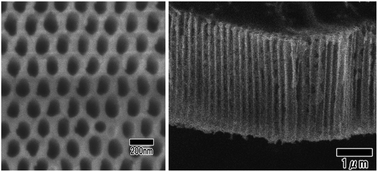Fabrication of ideally ordered TiO2 through-hole membranes by two-layer anodization
Abstract
Ideally ordered TiO2 through-hole membranes were obtained by a combination of Ti substrate pre-patterning and two-layer anodization. The Ti substrate was pre-patterned by Ar ion milling using ideally ordered porous alumina as an etching mask. Each concave pit formed by dry etching acted as an initiation site for hole development during anodization, and ideally ordered anodic porous TiO2 was produced by anodization using an electrolyte containing fluoride ions. Two-layered anodic porous TiO2 samples with different solubilities were formed by heat treatment for the crystallization of the first anodized oxide layer and a subsequent second anodization. The selective dissolution of the lower part of the two-layered porous TiO2 produced an ideally ordered TiO2 through-hole membrane. Using the present process, the repeated preparation of ideally ordered TiO2 membranes can be conducted because the ideally ordered concave array, which corresponds to the hole arrangement at the bottom of the detached TiO2 membrane, is maintained even after detaching the membrane. The obtained samples can be applied to various functional devices, such as photonic crystals and filtration membranes with photocatalytic properties.



 Please wait while we load your content...
Please wait while we load your content...